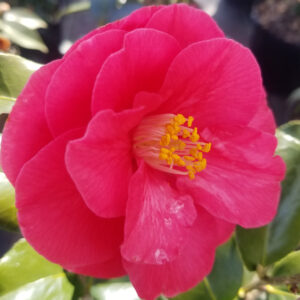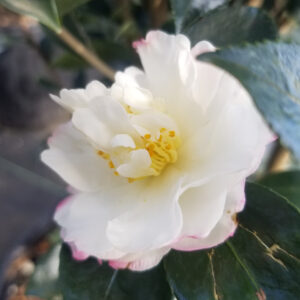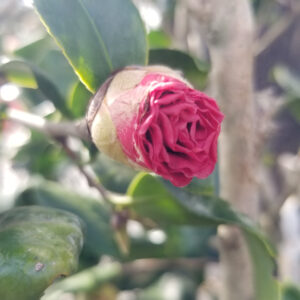
Camellia japonica ‘Jacks’
Camellias are a beautiful and popular flower that can add a touch of elegance to any garden. With the right care and attention, you can successfully grow camellias here in central Florida and enjoy their beauty during the seasons when most other flowering plants go dormant.
The first thing to consider when growing camellias in our area is the climate. Camellias are native to Asia and prefer a cooler, more temperate climate. This can be a challenge in our area, where the weather is often hot and humid. To help your camellias thrive, it’s important to choose a location that receives at least partial shade during the hottest part of the day. This can be provided by nearby trees or a trellis or pergola.
Another important factor to consider when growing camellias is soil. Camellias prefer well-drained, acidic soil with a pH of between 5.5 and 6.5. If your soil is too alkaline, you can amend it with peat moss or sulfur. It’s also important to make sure that your camellias are planted at the right depth and that they are not too close together.

Camellia japonica ‘Christmas Beauty’
Once your camellias are planted, it’s important to keep them well-watered. They prefer consistently moist soil, but not waterlogged. Use a watering can or a hose with a gentle spray to water your camellias, and avoid using a sprinkler system.
Camellias also require regular fertilization to thrive. Use an acid-based fertilizer specifically formulated for camellias and azaleas. We recommend fertilizing your camellias in early spring, mid-summer, and again in the fall.

Camellia sasanqua ‘Autumn Rocket’
Pest control is also important when growing camellias in central Florida. Camellias are susceptible to a number of pests, including scale insects, mealybugs, and spider mites. Keep an eye out for these pests and treat them promptly if you notice any signs of infestation.
Pro tip: The best time to prune Camellias is right after they are done blooming. The plants will set the next season’s flower buds soon after the old flowers have expired. So if you wait too long to prune, you will likely sacrifice some of your blooms for the following season.
Camellias come in a wide variety of colors and sizes, making them a versatile addition to any garden. Some of the popular varieties that we typically carry at Canterbury Farms:
- Japonica: This is the most common variety of camellia and is known for its large, showy blooms that can be red, pink, or white. Japonicas typically bloom in the winter and early spring.
- Sasanqua: These camellias bloom a bit earlier than japonicas, usually in the fall. They have smaller flowers than japonicas, but they are still quite showy. Sasanquas are known for their tolerance to heat and humidity, making them a good choice for central Florida.

Camellia flower bud
It’s important to note that camellias can take several years to reach maturity and begin blooming, so be patient and enjoy the journey of growing them. It’s also worth noting that the blooming time can vary depending on the variety, location and the weather conditions.
When choosing a camellia variety, take into consideration the size of the plant, the color and size of the blooms, and the blooming time. With the right variety and care, you can enjoy beautiful camellias in your garden for years to come.

